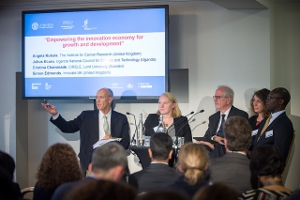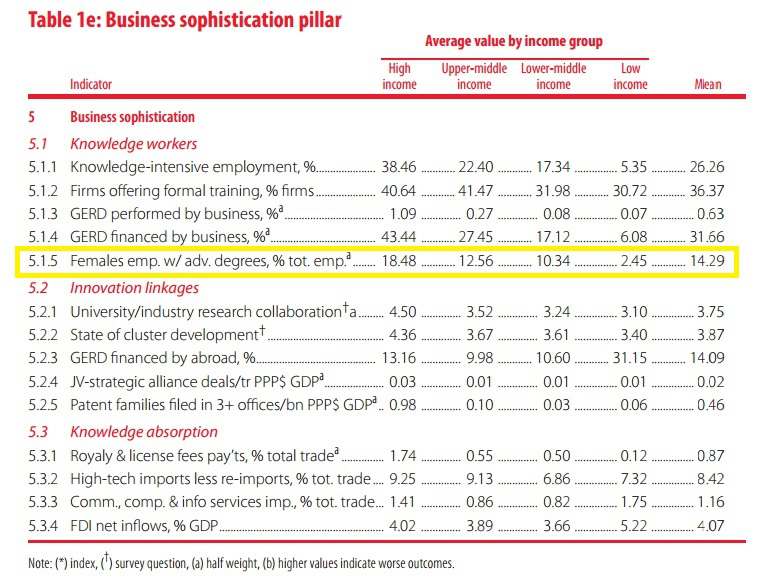Global Innovation Index (GII) 2015 Gets Gender Angle
January 12, 2016
For the first time in its existence, the GII 2015 includes a gender-related indicator. We talked to Sacha Wunsch-Vincent, Senior Economics Officer at WIPO’s Economics and Statistics Division to find out more.
This is the first time that a gender-related indicator has been included in the Global Innovation Index. How and why did you include this indicator in the GII 2015?

There is a great deal of interest in better understanding the innovation role and contribution of women – in particular female researchers and entrepreneurs. Economists and innovation scholars are working to improve the evidence-base on this topical matter. Policy-makers in turn are keen to make the most of women-driven innovation and to address potential gender imbalances.
To reflect this debate, the team of the Global Innovation Index (GII) has pondered whether to include a gender-related variable in the GII for a number of years. Three obstacles surfaced.
First, the development of rich metrics on the female contribution to innovation is still in its infancy. Data on the proportion of women in various areas can be found in:
- education statistics, e.g. the percentage of females among science and engineering (S&E) graduates;
- labor force statistics, e.g. the share of females in the work force; or in
- more traditional research and development statistics, e.g. the share of female researchers.
Data on female innovators however are harder to come by. Even the shares of female patent applicants or female entrepreneurs are typically not available from official sources. Moreover, on their own, none of the above indicators is likely to fully capture the role and contribution of women to country-level innovation.
Second, as the GII covers more than 140 countries, the data to approximate the female contribution to innovation needs to have quite extensive country coverage. This is hardly ever the case with the aforementioned available gender-related indicators.
Third, when including a new variable in the GII one needs to have a clear view on how the inclusion of this variable will impact the country rankings. Many seem to agree that current shares of women in S&E graduates, patentees, or entrepreneurs are too low. That being said, little is known about the optimal share of women in any of the above indicators. The default is to assume that gender parity (50%), and the resulting equal opportunity and greater diversity are ideal. Yet, this assumption is not backed by sufficient evidence.
Despite these limitations, it was time to start addressing the topic of gender and innovation in the GII. In our experience, the inclusion of innovation themes and variables in the GII helps generate more attention for important innovation topics. As a result, more detailed analytical work and debates are taking place, furthering the research topic at hand. The statistical community is also encouraged to more quickly develop adequate metrics. Finally, this global ranking also shows how countries are performing with regards to the new variable.
The new indicator is entitled “Females employed with advanced degrees”. Can you explain a bit more about what exactly it shows?
The GII team decided to include a metric showing the intensity of highly-educated women as a share of the total workforce. For this we consider the percentage of employed females with advanced degrees as a share of the total workforce. In the GII, this data point complements others related to knowledge workers as part of the package of metrics assessing overall domestic business sophistication. We worked with data and colleagues from the International Labour Organization (ILO) to include this data point.
Indeed, it yields some interesting results. In some countries about one third or one fourth of the workforce is made up of women with advanced degrees. This is the case not only in many Eastern European countries such as Lithuania, and other countries with a historically high rate of female labor participation such as Russia, but also in other high-income countries such as in the Nordic countries (Finland, Sweden and Norway).

It’s regrettable that even this basic indicator is not available for more than 50 out of the 141 GII countries, including a number of high-income countries. However I hope that this will change soon!
What further gender-related developments do you envisage for the GII 2016?
For the 2016 edition of the GII we will continue to trial the above indicator and to further improve its coverage. Importantly, we will continue to underline the need for better and more available gender and innovation indicators as we present the GII to international fora, to the statistical community, and on country missions.